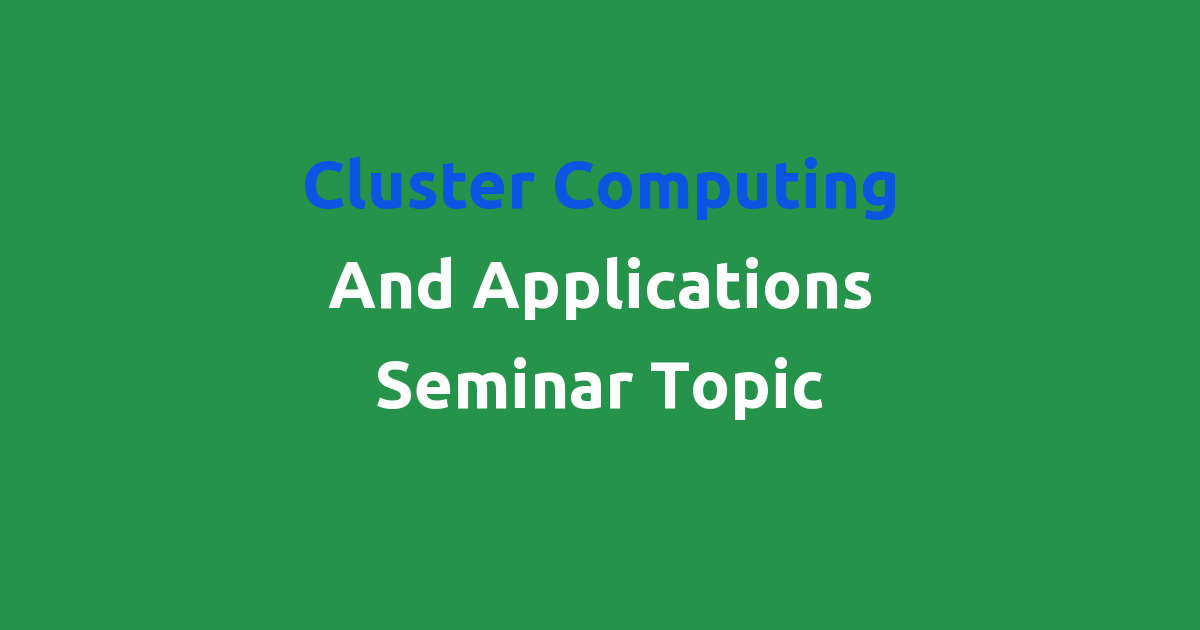Seminar Topic: Exploring the Potential of Cluster Computing and its Applications
Cluster Computing and Applications Seminar Topic
Introduction
Cluster computing is a type of parallel or distributed computing that allows multiple computers (often referred to as nodes) to work together to solve a problem or complete a task. This technology is widely used in various fields such as scientific research, data analysis, machine learning, and more. In this seminar topic, we will delve deeper into cluster computing, its applications, advantages, and proposed improvements.
Problem Statement
While cluster computing has revolutionized the way large-scale computations are performed, there are still some limitations and drawbacks associated with the existing systems. These include high setup and maintenance costs, limited scalability, and lack of fault tolerance. Additionally, the performance of the system can be affected by network latency and communication overhead.
Existing System
The existing cluster computing systems typically consist of a master node and multiple worker nodes. The master node coordinates the tasks and distributes them among the worker nodes, which perform the computations in parallel. While this system allows for faster processing of tasks, it is not without its challenges. The setup and maintenance of the system require specialized skills, and scaling the system to accommodate additional nodes can be complex and costly.
Disadvantages
Some of the disadvantages of the existing cluster computing systems include:
1. High setup and maintenance costs
2. Limited scalability
3. Lack of fault tolerance
4. Performance degradation due to network latency
5. Communication overhead
Proposed System
To address the limitations of the existing systems, we propose a new cluster computing system that incorporates improved fault tolerance, scalability, and performance optimization. The proposed system will feature a decentralized architecture that distributes tasks and resources more effectively among the nodes. Additionally, the system will utilize advanced algorithms to minimize network latency and communication overhead.
Advantages
The proposed cluster computing system offers several advantages over the existing systems, including:
1. Improved fault tolerance: The decentralized architecture reduces the risk of a single point of failure, ensuring that the system can continue to operate even if a node fails.
2. Enhanced scalability: The system can easily accommodate additional nodes without significant complexity or cost, allowing for seamless expansion as needed.
3. Optimized performance: Advanced algorithms and optimization techniques are employed to minimize network latency and communication overhead, resulting in faster processing times.
4. Cost-effective: The decentralized architecture and optimized performance of the system help lower setup and maintenance costs, making it a more cost-effective solution for large-scale computations.
5. Ease of use: The proposed system will be designed with user-friendly interfaces and tools to make it easier for users to set up, monitor, and manage the cluster.
Features
Some key features of the proposed cluster computing system include:
1. Decentralized architecture: Tasks and resources are distributed among the nodes in a decentralized manner, improving fault tolerance and scalability.
2. Advanced fault tolerance mechanisms: The system incorporates advanced fault tolerance mechanisms to ensure uninterrupted operation in the event of node failures.
3. Performance optimization: Algorithms and techniques are used to optimize performance and reduce network latency and communication overhead.
4. Scalability: The system can easily scale to accommodate additional nodes, making it suitable for large-scale computations.
5. User-friendly interface: The system will feature a user-friendly interface that simplifies setup, monitoring, and management tasks for users.
Conclusion
In conclusion, cluster computing is a powerful technology that has transformed the way large-scale computations are performed. However, the existing systems have limitations that need to be addressed to fully realize the potential of cluster computing. The proposed system aims to overcome these limitations by offering improved fault tolerance, scalability, and performance optimization. With its decentralized architecture, advanced fault tolerance mechanisms, and optimized performance, the proposed system promises to be a cost-effective and user-friendly solution for cluster computing applications.

